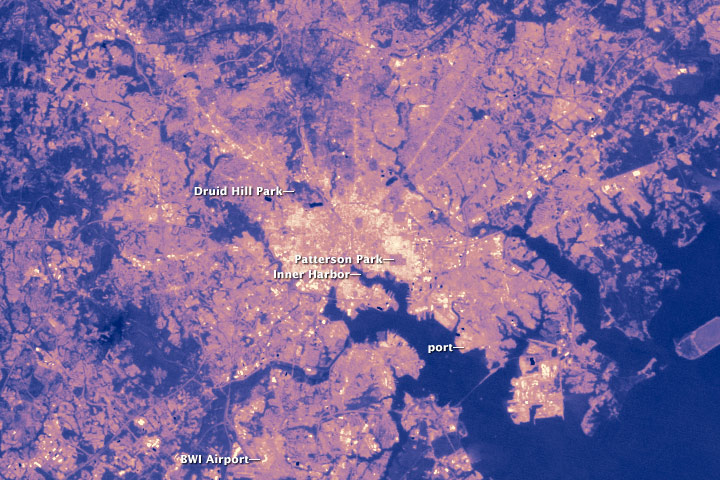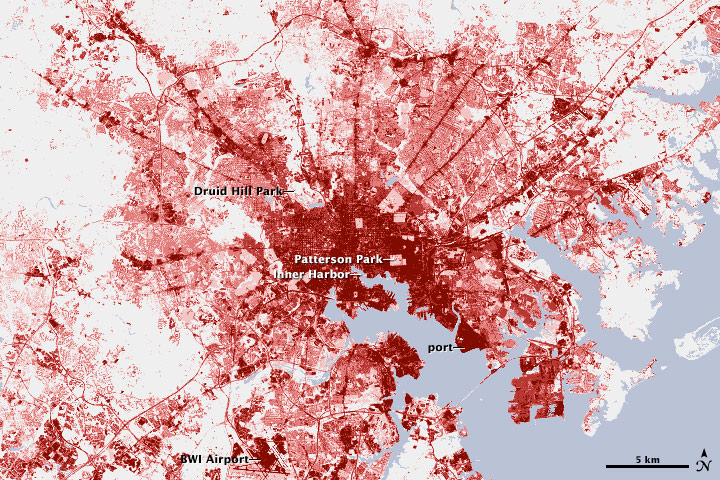

Urban Heat Island: Baltimore, MD
Downloads
- baltimore_etm_2001214_lrg.jpg (1684x1734, JPEG)
- baltimore_lcc_2001_lrg.png (1684x1734, PNG)
Metadata
- Sensor(s):
- Landsat 7 - ETM+
- Data Date: August 2, 2001
- Visualization Date: December 18, 2008
A winter storm creeps over your city. Out in the suburbs, snow and ice coat the ground, but in the city center, the snow melts away without sticking. On a hot summer day, the heat seems much more oppressive downtown than in the rural areas beyond the edge of the city. In both cases, the difference between the city and its surroundings can be chalked up to the urban heat island effect. In general, cities are warmer than rural areas because asphalt, concrete, steel, and bricks absorb sunlight and release heat back into the atmosphere. Plants, on the other hand, use solar energy to create sugar through photosynthesis. They also respire water, and these things together keep the ground cool.
The relationship between temperature and land cover is shown in this pair of images. The top image shows the approximate temperature of the land surface (how hot the land would be to the touch) on a summer’s day in Baltimore, Maryland. The highest temperatures are yellow, while cool temperatures are deep purple. The image was made from data collected by the Landsat satellite on August 1, 2001. The lower image shows how developed the landscape around Baltimore is. Areas that are red have a high concentration of cement and asphalt (impervious surfaces), while white areas are primarily covered by plants. This image was made with land cover data compiled from Landsat observations.
The warmest temperatures map perfectly with highly developed land. Pockets of cool in the city are plant-covered parks. Spikes in temperature away from the city occur along the spokes of development radiating out from the city and near the airport. Using similar data sets, researchers at NASA Goddard Space Flight Center study how land surface temperature correlates with land development in cities around the country. The fraction of land that is covered in impervious surfaces (roads, buildings, etc) maps well to the change in temperature caused by the urban heat island effect. The relationship is strongest in the northeastern United States, where the land around the city is covered with a temperate forest. In Baltimore, the land surface temperature changes by as much as 10 degrees Celsius going out from the city center, the researchers found.
But not all urban heat islands are equal. Cities in arid regions, like Las Vegas, Nevada, are actually cooler than the surrounding landscape because people plant and irrigate grass and trees in the city, whereas the natural climate does not support such cooling vegetation. The researchers also found that in temperate regions, such as the northeastern United States, the temperature difference between the city and the less developed rural landscape depends on the size of the city. A larger city will create a larger heat island, so temperatures will be higher in a large city than a small city. Practically speaking, this means that as cities grow, their residents will have to expend more energy (and money) for cooling during the summer.
Ping Zhang, Marc Imhoff, Robert Wolfe, and Lahouari Bounoua presented the research on December 18, 2008, at the fall meeting of the American Geophysical Union.
NASA images by Robert Simmon, based on data from the National Land Cover Database and Landsat 7. Caption by Holli Riebeek.
This image record originally appeared on the Earth Observatory. Click here to view the full, original record.